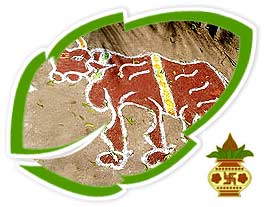History of Pongal
*****************
Pongal is an ancient festival of people in South India particularly Tamils. The history of the festival can be traced back to the Sangam Age i.e. 200 B.C. To 300 A.D. Although, Pongal originated as a Dravidian Harvest festival and has a mention in Sanskrit Puranas, historians identify the festival with the Thai Un and Thai Niradal which are believed to have been celebrated during the Sangam Age.

Observance of Pongal During the Sangam Era (Thai Niradal)
*********************************************************
The celebrations of Sangam Era led to today's Pongal celebrations. As part of the festivities, maidens of the Sangam era observed 'Pavai Nonbu' at the time of Thai Niradal which was a major festival during the reign of the Pallavas (4th to 8th Century AD). It was observed during the Tamil month of Margazhi (December-January). During this festival young girls prayed for rain and prosperity of the country. Throughout the month, they avoided milk and milk products. They would not oil their hair and refrained from using harsh words while speaking. Women used to bath early in the morning. They worshiped the idol of Goddess Katyayani, which would be carved out of wet sand. They ended their penance on the first day of the month of Thai (January-February). This penance was to bring abundant rains to flourish the paddy. These traditions and customs of ancient times gave rise to Pongal celebrations.
Andal's Tiruppavai and Manickavachakar's Tiruvembavai vividly describe the festival of Thai Niradal and the ritual of observing Pavai Nonbu. According to an inscription found in the Veeraraghava temple at Tiruvallur, the Chola King Kiluttunga used to gift lands to the temple specially for the Pongal celebrations.
Legends of Pongal
*****************
Some legendary stories are also associated with Pongal festival celebrations. The two most popular legends of Pongal are stories related to Lord Shiva and Lord Indra.
According to a legend, once Shiva asked his bull, Basava, to go to the earth and ask the mortals to have an oil massage and bath every day and to eat once a month. Inadvertently, Basava announced that everyone should eat daily and have an oil bath once a month. This mistake enraged Shiva who then cursed Basava, banishing him to live on the earth forever. He would have to plough the fields and help people produce more food. Thus the association of this day with cattle.
Another legend of Lord Indra and Lord Krishna also led to Pongal celebrations. It is said when Lord Krishna were in his childhood, he decided to teach a lesson to Lord Indra who became arrogant after becoming the king of all deities. Lord Krishna asked all the cowherds to stop worshiping Lord Indra. This angered Lord Indra and sent forth his clouds for thunder-storms and 3 days continuous rains. Lord Krishna lifted Mount Govardhan to save all the humans. Later, Lord Indra realized his mistake and divine power of Krishna.
Pongal Celebrations
*******************
According to Hindu mythology, this is when the day of the gods begins, after a six-month long night. The festival is spread over three days and is the most important and most fervently-celebrated harvest festival of South India. A special puja is performed on the first day of Pongal before the cutting of the paddy. Farmers worship the sun and the earth by anointing their ploughs and sickles with sandal wood paste. It is with these consecrated tools that the newly-harvested rice is cut.
Each of the three days are marked by different festivities. The first day, Bhogi Pongal, is a day for the family. Surya Pongal, the second day, is dedicated to the worship of Surya, the Sun God. Boiled milk and jaggery is offered to the Sun God. The third day of Pongal, Mattu Pongal, is for worship of the cattle known as Mattu. Cattle are bathed, their horns polished and painted in bright colors, and garlands of flowers placed around their necks. The Pongal that has been offered to the Gods is then given to cattle and birds to eat.
